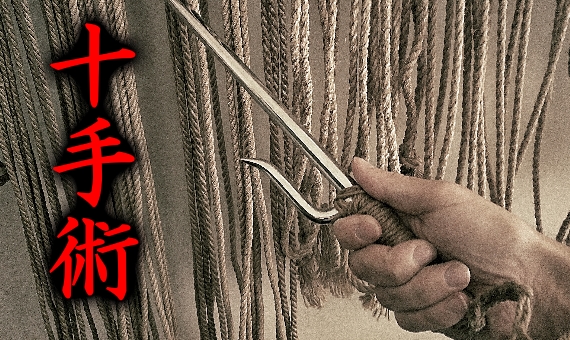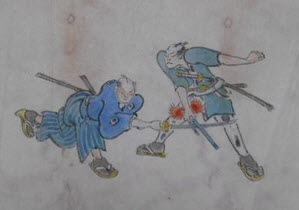History
Jutte, or Jitte, as it can also be romanized, is the most famous baton-like weapon in Japan and in the West. It consists of a short metal rod which is round, square, hexagonal or octagonal and a cross-section, and is usually provided with an L-shaped hook known as tachimogi no Kagi (literally “sword picking hook) just above the handle. The are some versions that have a small fender and is without a hook, and others that have several hooks, and still some of both the hook and the fender.
Metals used were wrought iron and brass. The iron could be coated with a mixture of silver and mercury, which gave a shiny effect as if it were polished. Since this coating is often released, some silver, and therefore some Jutte were called Ginbo (silver rods 銀棒).
The Jutte handle was usually no different from the rest of the metal bar, but it is possible to find models with the handle wrapped in leather, sharkskin, rattan, or had brass bands. Special models had a handle similar to a sword. Some models even had a scabbard for storage.
Jutte often associated with the Edo period police officers and was a symbol of his authority as well as a useful tool to arrest criminals. Depending on the time period, the user’s social rank, and the level of danger he might encounter, could be expressed in the length of Jutte, which varied quite a bit. In addition to being a symbol of the Edo period policemen, some who carried Jutte were actually, very often the criminals.
There was a great variety of Jutte models, and one source says that there were about 200 different types used during the Edo period. The length varied from 25-28 cm for short. And from 55-64 cm for the long models. Before the Edo period there were long models that could measure up to between 70 and 90 cm. Some were called futokoro Jutte , Koshi Jutte and koshizashi because they could easily be hidden in a futokoro (kimono pocket) or tucked into the belt behind your back because you could deploy it quickly. Some longer Jutte was more designed for real battle with armed and dangerous criminals and ronin and such were called sentoyo jutte (battle Jutte). The aim of the Jutte was to provide protection, and when you hold it in reverse grip with the metal bar along the forearm, the tip should extend beyond the elbow.
Around the Kyoho era (1716-36) a law began to come into effect that determined a standard for the official police Jutte. At one time, the standard length was about 36 cm. Different standards and personal models of Jutte was, therefore, discretionary in the Edo period, however, officers would be provided with a service-Jutte when they were out on patrol or to arrest a criminal, but they had to return it to the station afterwards. It was only to be used under the supervision of a senior officer and was not allowed to be taken home. Therefore many lower ranked officers made or ordered a private Jutte that they wore when they were not in service. Jutte used by the officer had a string and a tuft of different colors, depending on the degree. Lower ranking officers did not have Jutte with cord and tassel. This tassel-less Jutte was called bozujutte (“bald Jutte”).
Despite the fact that Jutte is a well-known weapon its light is hidden in darkness, and there are several theories about its origin, some more reasonable than others. Jutte, or more correctly Jutte-like weapons, has been known by many names. You can not list them all but the best known is
- Jutte
- Jittei
- Koppu
- Tebo
- Tekkan
- Kesan
- Tettei
- Ginbo
- Tesshaku
- Jittetsu
- Jutto
- Sakate
- Tenki



Leave a comment